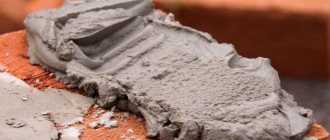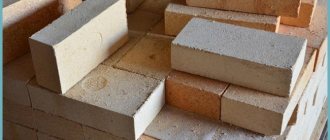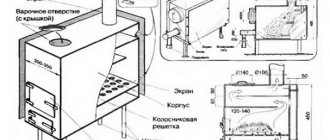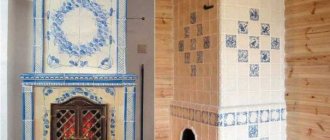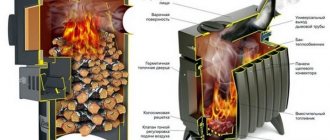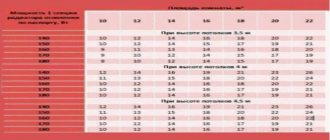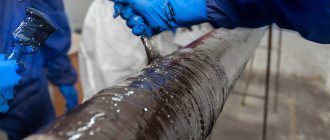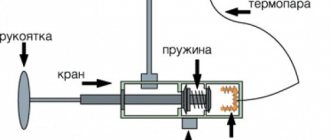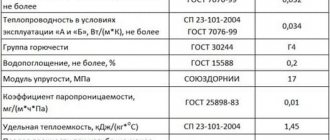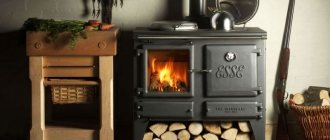Purpose and technical characteristics of the product
Cast iron stove plates, also called cooking floors, are mounted directly on the upper horizontal plane of the stove. They are used for cooking and heating the room. This element has inertial heat transfer: the hot cast-iron surface cools down for a long time, while evenly heating the room and at the same time performing the function of a hob.
The product is produced by casting. The material used is gray cast iron grade SCh 15-20. This metal is a compound of iron and carbon (more than 2%) and is characterized by high strength and fire-resistant properties. Gray cast iron also contains silicon, phosphorus, manganese and sulfur. The presence of such impurities significantly improves the physical and chemical characteristics of the metal.
The cast iron stove plate is resistant to temperature changes, does not deform during operation and maintains its integrity throughout its entire service life.
Cast iron hob on a modern fireplace stove
For your information! Any products made of gray cast iron are immune to corrosion, since their surface is covered with a layer of rust immediately after casting. It is this “protective” layer that prevents corrosion from penetrating deep into the metal.
Advantages of cast iron
Cast iron provides the product with inertial heat transfer, which means that slow cooling of the surface contributes to uniform heating of the room. Cooking decks are cast from SCh 15-20 cast iron (carbon combined with iron), which is famous for its strength and fire resistance.
Phosphorus, sulfur, silicon and manganese added to the composition enhance the chemical and physical properties. That is why cast iron structures are not subject to temperature changes and remain intact for quite a long time of operation. In addition, any cast iron structures will not be subject to corrosion due to the rusty layer covering them.
Two types of cast iron stoves
The material for them is gray cast iron grade SCh . It molds well and has a sufficient margin of strength and elasticity. To improve performance, silicon, sulfur and manganese additives are added to the composition, and the carbon content is about 2% .
Cast iron is not afraid of high temperatures and retains its shape at any degree of heating. The surface does not oxidize or rust over time due to the durable oxide film formed during the casting process.
The slabs are either solid or collapsible . Collapsible ones consist of several rings with a small thermal gap. It is necessary for proper temperature compensation.
Monolithic surface with burners
This is a solid sheet of metal with a thickness of at least 8 mm. It can be equipped with fixed-sized burners (recesses or protrusions in food preparation areas). Blind slabs do not have recesses. Hobs of this type are the easiest to install and have a low cost , therefore they are very popular in inexpensive ovens.
Important! Due to the fact that there are no open burners, in order to heat a kettle or pan, you have to heat up the entire stove, and this is an extra waste of fuel.
Disadvantages of solid slabs:
- the inability to regulate the temperature in the burner, you have to heat the entire surface;
- the lack of gaps makes the stove very sensitive to strong heat .
Collapsible cast iron construction
A special feature of the design is several rings of different diameters , which fit into each other like a puzzle. By removing the rings, you can select the optimal caliber of the burner for a specific pot or frying pan.
This scheme provides many advantages over the traditional one:
- High reliability and surface rigidity. It is not afraid of heating due to the gaps between the parts of the burner, which protect the metal from deformation.
- Possibility to regulate the heating intensity by opening individual sections. Cooking takes place over an open fire and does not require complete heating of the entire surface. This saves time and wood.
Important! The cookware must be suitable for use over an open fire. Cast iron and aluminum cookware are best suited for this .
Types of cast iron decking
The hob for a cast iron stove can be produced in two types: prefabricated and solid. The differences between these types are insignificant, because both perform their main functions: heating and cooking.
Prefabricated slabs
These structures consist of a sheet of cast iron and several round parts of different types. Cast iron stove rings fit into each other like a puzzle. Due to the fact that the surfaces have gaps, the metal does not deform under the influence of high temperatures.
And the different diameters of the rings allow you to cook food in different dishes as quickly as possible. After all, to heat a large pan of water, you can use a circle with the largest diameter, and it is more convenient to place an iron mug on the smallest part.
Solid slabs
A cast iron sheet for a stove with a solid surface or burners of standard diameter belongs to the category of solid decks. Due to the integrity of the structure, they do not have any gaps for the narrowing and expansion of the metal.
This feature reduces the practicality and durability of such products. But they also have their advantages. Easy installation and relatively low price due to the simplified design are liked by many buyers.
Which is better - steel or cast iron?
The hob for the stove is made of cast iron or metal. Which product has more advantages: cast iron or steel stove plate?
There are a huge number of manufacturers of these products who insist on the advantages of cast iron over steel.
Advantages of cast iron decking:
- strength and durability. A cast iron stove will reliably serve you for decades.
- heat dissipation Due to the presence of certain chemicals in the cast iron used for casting sheets, it has better physical characteristics compared to steel.
- resistance to deformation and corrosion.
- resistance to temperature changes. Due to this, the cast iron hob for the stove retains its original appearance throughout its entire use.
Some manufacturers focus on some other advantages of cast iron compared to steel: cast iron does not dry out the air as much. You don't have to use humidifiers or other devices to maintain indoor humidity.
The main advantages of steel plates are:
- fast heating. In just a couple of minutes the surface heats up to the desired temperature. But such a stove cools down much faster than a cast iron one.
- light weight. Typically, steel plates weigh ten times less than cast iron. This allows for quick installation without much effort. But due to their low weight, such products are able to withstand a small load. If you will be using fairly heavy cookware, it is better to give preference to a cast iron stove.
- low cost. Prices for cast iron stove stoves are higher than for steel stoves. But their service life is much longer.
Conclusion: If your budget allows, use a cast iron surface, it will last longer. If your budget is limited, buy a steel plate.
How to choose?
Choosing a cast iron deck for your stove is not difficult. To buy a quality product, the installation of which will not require much effort, it is enough to take into account several nuances.
What are the sizes of cast iron sheets?
Cast iron sheets can be square or rectangular. The most popular are rectangular slabs. The surface dimensions directly depend on the size of the oven.
The standard dimensions of a cast iron stove for a stove are:
- 34 by 41 cm,
- 71 by 41 cm,
- 66 by 41 cm,
- 51 by 34 cm.
For a non-standard stove, you can order the service of manufacturing a cast iron sheet with individual parameters in a specialized store. But it will cost significantly more than standard products.
Number of burners in different models
Typically ovens have two burners. But their number can vary from one to six (it all depends on the surface area). Solid cast iron sheets may have no holes at all. But the cooking time on this type of stove can be long due to the slow heating of the cookware.
Other criteria for choosing a quality product
You should pay attention to the quality and composition of the material from which the stove is made. If you find chips, scratches and other various defects on the surface, then it is better to refuse the purchase. A high-quality product has a smooth surface and its weight is quite large. There are no lightweight cast iron stoves.
It is worth taking the time to study the composition of cast iron. Cast iron, which is used for smelting, is a combination of 2% carbon with iron. But if it contains any components unknown to you, be sure to ask the seller about them. After all, some chemical elements are not environmentally friendly and can harm your health.
What are stoves needed for?
Cast iron plates are characterized by inertial heat transfer - they cool down for a long time. Heated panels are able to evenly transfer heat to the room for several hours. Using cast iron equipment, you can kill two birds with one stone - along with heating, this is an excellent help when cooking.
Cast iron stove stoves are made in two main formats, which allows you to adapt the products to your needs. The format and size variability make it possible to select panels based on the dimensions and purpose of the dishes.
Types of cast iron cooking floors
Regardless of the configuration, all tiles perform an excellent heat transfer function and you can cook food on them. Cooking decks come in two types – prefabricated and solid. The difference between the former is in the thermal gaps between the parts, due to which the expansion of the heated metal is compensated. But each type also has additional features.
Prefabricated slabs
Structurally, they look like metal panels with several rings of different diameters that are installed into each other. The result is a single plane. Prefabricated stove stoves can have from one to six burners, and their size can be varied for specific cookware by removing and putting on the rings.
Cast iron prefabricated stove slabs are characterized by a long service life and resistance to temperature changes. Due to the inter-ring gaps, cast iron, which expands when heated, is not deformed or damaged.
To make the products more durable, they are equipped with stiffening ribs on the inside. A significant advantage of such an addition is an increase in panel temperature and increased efficiency.
Caring for a cast iron cooktop
Cast iron is an unpretentious , but even it has its weak points. First of all, it is natural fragility . Careless handling of the slab or impacts lead to the appearance of cracks and chips on the surface. It is impossible to weld defects , so such a slab will have to be thrown away.
The hot plane is sensitive to liquid contact . A sudden cooling of the slab is fraught with the appearance of cracks and a violation of the tightness of the seal.
The surface of the slab does not require additional treatment with any compounds. It is enough to regularly wipe the cold stove with a damp cloth , and remove burnt food residues with a stiff brush . Rust deposits due to long periods of inactivity will disappear immediately after heating the stove.
for cleaning surfaces are popular : baking soda, soda with vinegar, ammonia and hydrogen peroxide, mustard powder . Do not use flammable liquids (solvents, acetone) or strong detergents containing acids. It is best to use mechanical cleaning methods various abrasive materials.
Main manufacturers of cooking floors
Cast iron slabs are produced by both foreign and domestic companies. Among foreign slabs, the most popular and in demand slabs are brands of Finnish origin - Pisla and HTT .
We can proudly note that domestic manufacturers are not lagging behind and produce products no worse.
Among the range of stove surfaces produced in Russia, NMK, Litkom, and SibStalShar slabs stand out. In addition to the quality characteristics, along with strength and temperature resistance, one can note the aesthetic appearance of the cooking floors. Thanks to the desire to surprise and win over the buyer, manufacturers have done a great job of creating a competitive product of the highest level.
All stoves on the market are divided into two categories: prefabricated and solid cast iron stoves.
Cooking floors "Litkom"
Main advantages:
- Beautiful appearance in an elegant embodiment.
- Thermal stability – resistance to high temperatures up to 1000 °C;
- Environmentally friendly - manufactured using materials that are harmless to the life and health of users.
Below is the range of Litkom stove surfaces
| Name | Bookmark size | Average weight | price, rub. |
| Stove with one hole for burners for a cauldron up to 20 l. P1 – 5 | 512x512x10 | 21.3 kg. | 3 755.40 |
| Stove with one hole for burners for a cauldron up to 40 l. P1 – 6 | 600x600x16.5 | 46.16 kg. | 8622.70 |
| Stove stove “Warm Potok” P1–7 | 413x340x8 | 9.32 kg. | 1229,60 |
| Stove with one hole for burners PS2–3/2 | 362.5x410x8 | 10.04 kg. | 1 314,98 |
| One-piece stove with two holes for burners P2–3 | 710x410x12 | 24.56 kg | 3140.25 |
| Prefabricated stove with two holes for burners PS2–3 | 710x410x8 | 19.98 kg. | 2260.11 |
| Stove flooring | 410x245x15 | 10.5 kg. | 1 053,92 |
| A stove with one hole for burners for a cauldron up to 20 liters. Art.D–440 | 640*640*10 | 54.3 kg. | 12526.26 |
Let's consider two more popular models of stove stoves from the Balezinsky Foundry and Mechanical Plant:
- Single-burner cast iron stove stove P 1–2 (710*410): dimensions 710*410 mm, material – cast iron, price – 2180 rubles.
- Cast iron stove stove PS (710*410): dimensions 710*410 mm, material – cast iron, price – 2260 rubles.
Cast iron stove for stove P 1-2
Cast iron stove for P 1-2 stove Cast iron stove for PS stove
Subtleties of installing the stove on the stove
First of all, it is necessary to take into account the characteristics of thermal expansion of various materials. For example, brick and cast iron behave completely differently under the influence of high temperatures, and if you wall the hob end-to-end in the masonry, then such a stove will not last long. It will simply collapse due to the expansion of the metal.
Correct installation of the stove requires a 5 mm gap around the entire perimeter, without coating. Thus, when heated, the stove element will have sufficient free space for expansion, and the brickwork will maintain its integrity.
The top row is laid out “dry” (without mortar) in order to correctly lay the future expansion gap
During installation, a clay-asbestos solution of liquid consistency is used. It is used to fix the cast iron stove on the stove. The solution is prepared as follows: crushed asbestos is added to clay diluted with water, and then, gradually adding liquid, the compound is brought to the state of “liquid sour cream.”
The stove plate is always laid level. And the burner with the largest diameter is located directly above the firebox.
The top row of the stove masonry is secured with a steel angle along the entire perimeter of the stove, thus increasing the strength of the entire structure.
For your information! After installing a new cast iron cooking floor, the first firebox is carried out according to a special scheme. Slowly, over 8 hours, heat the oven to a temperature of about 600°C. This means that every hour the temperature of the heat-releasing surfaces should increase by 75-85°C. This gradual annealing eliminates the internal stress of cast iron, which significantly enhances its strength characteristics.
Installing a cast iron stove on a stove is no joke. The length of operation of the product directly depends on the accuracy of installation, so such important work should be entrusted to professionals.
Nuances of installing slabs
Not only the efficiency of the panel, but also the safety of users depends on the choice and quality of installation of a cast iron stove stove. A poor-quality product and/or incorrect installation can lead to destruction of the slab during operation. Considering the dimensions of the dishes, the high temperature and the difficulty of quickly neutralizing the problem, the selection and installation must be approached with great responsibility.
A few recommendations regarding the installation of the stove stove:
- there must be a 5 mm gap in the horizontal plane between the stove and the cooking floor; the distance between objects compensates for thermal expansion and increases the service life;
- a large burner is installed above the firebox;
- the stove must be installed strictly horizontally; to correct the horizon, use a bubble level; in addition, the base must be level - panel play is not allowed;
- the cast iron sheet is installed on a mixture of clay and asbestos - these materials are resistant to high temperatures; solution preparation scheme: clay is diluted with water;
- crushed asbestos is added to the mixture of water and clay;
- Add water little by little to the solution until a creamy mixture is formed;
Please note that horizontal gaps must be left empty, otherwise the cast iron will destroy the brickwork;
- the upper masonry row (on which the slab is installed) is “ringed” with a metal corner - this makes the structure stronger.
Instructions for use and care
Careful handling of the product will increase its service life.
- The correct first firebox is the key to the durability of the flooring. It is necessary to gradually light the firebox (shavings and small logs first) and allow it to cool for several hours.
- Mechanical damage should be excluded: chips, scratches.
- Rust may appear during storage of the stove. You should not rip it off or try to remove it in other ways. It will disappear during use.
- Do not overload the device.
- It is necessary to ensure that moisture does not fall on the heated flooring.
With proper use and proper care, your stove will last for many years.
What should it be
It would seem that there is nothing easier than replacing the suitable surface of a brick oven with a metal insert with your own hands, getting a stove for cooking. In reality, everything is much more complicated. A stove is a complex device, and the thermophysical processes occurring in it depend on the correct arrangement of its elements.
There are special requirements for furnaces of this type. On the one hand, it must effectively accumulate heat in the thickness of the brickwork, on the other hand, it must take a significant part of the heat to heat the hob . In the summer, when heating the house is not required, the hob should warm up quickly with economical fuel consumption.
Requirements
Theoretically, the hob can be made from any material that can heat up to high temperatures when the stove is fired. In practice, they use cast iron plates with holes covered with a removable lid.
This design allows you to create zones with different temperatures on the stove. The thermal conductivity of cast iron, unlike steel, is not very high, so you can heat food on the plane of the stove, as well as cook or stew it over low heat. And by opening the lid, you can achieve direct heating of the cookware with an open flame, which allows you to quickly boil water or fry food in a frying pan.
The most practical are burners . shown in the photo, consisting of concentric rings of different diameters - they can be selected to fit the size of the bottom of the dish. In addition, the gaps between the rings compensate for the thermal expansion of cast iron that occurs when overheated, and the plate can withstand multiple heating and cooling cycles without damage. Solid cast iron stoves are less reliable and require more careful firing.
How to make a choice
You can buy an imported cast iron hob, for example, Finnish Pisla and HTT . Among domestic brands, products from NMK, SibStalShar, Litkom, and Balezinsky LMZ .
All of them have a beautiful appearance, heat resistance up to 1000°C and are environmentally friendly, without emitting harmful substances when heated.
For stove slabs, standard dimensions for laying are accepted: 710x410 mm, 340x410 mm, 660x410 mm, 585x340 mm and others. The number of burners in a typical section is one or two .
The thickness of cast iron in expensive slabs reaches 12 mm , and the structure itself has stiffening ribs on the reverse side. Weight is about 20 - 25 kg .
Technical aspects of cast iron slabs
The production method for stove panels is casting. The role of raw material is played by gray cast iron, marked as SCh 15-20. The numbers in the marking indicate the tensile strength expressed in kgf/mm2. It is not entirely correct to call cast iron gray, but this error is fixed at the GOST level. Although the color of the plates does reflect the name of the metal.
SP is a combination of carbon and iron, the two main components of the material. In addition, the composition includes a certain amount of sulfur, manganese, phosphorus and silicon. Impurities are the reason for the increase in the strength characteristics of cast iron.
A cast iron hob is different:
- heat resistance – high-quality slabs are immune to temperature fluctuations; high temperature does not cause deformation of the decking throughout the entire operational period;
- anti-corrosion characteristics; immediately after casting, the slabs are covered with a layer of rust, which makes them able to resist corrosion; Some products are additionally coated with a heat-resistant protective layer, but its function is rather decorative - after some time the protective layer wears off, which does not affect the operation of the stove.
The most popular panel sizes, mm:
- 340*410;
- 340*510;
- 340*585;
- 410*660;
- 410*710.
The thickness of the panels usually varies between 8-17 mm. Weight ranges from 10-55 kg. The Russian market offers products from both Russian and European manufacturers. Among the latter, the most common are slabs made in Finland.
Advice! Choose stoves according to the dimensions of the dishes. Yes, a stove for bulk containers may be more expensive, but a powerful product is a guarantee of comfort and a guarantee of safety.
Tips for increasing the life of cast iron stoves
To ensure that your stove hob lasts as long as possible, you should follow these simple rules:
- to lay the slab, use liquid cement mortar, maintaining a distance of 5–6 mm from the upper edge of the oven;
- The largest burner should always be located above the firebox;
- the brickwork of the top row must be strengthened with a steel angle;
- Do not forget that there should be gaps of up to 2 mm along the entire perimeter of the slab to prevent deformation and cracking of the metal;
- correctly load the stove for the first time and heat it, gradually warming it up for about 8
hours, and increasing the temperature by 70–80 degrees every hour. For proper heating, you need to start heating with shavings and wood chips, and then add larger firewood. After heating the stove for 8 hours, it must be left to cool until the firewood is completely extinguished.
Compliance with all operating and installation rules will not only extend the life of the stove and hob, but also guarantee the safety of the buyer and his loved ones.
If the buyer himself is not confident in his competence in installing cast iron slabs, then it is better to seek the help of professionals. Thanks to their special knowledge and many years of experience, they will help you save your time and nerves. This is the case when it is better to give way to a specialist, so that later you do not have to pay for your own inexperience.
And then, when you have at your disposal a beautiful stove with a properly installed cast-iron stove on the surface, you can fully enjoy the warmth and comfort emitted by such a design.
Main types of cast iron stoves
If you decide to buy a cast iron hob, contact a specialized salon or use an online store. The minimum price for a product is 500 rubles. It depends on the size, material and manufacturer. The most common sizes are slabs of 34*41 cm, 71*41 cm, 58.5*34 cm, 66*41 cm, 51*34 cm.
The most popular and sought-after foreign manufacturers include the Finnish brands Pilsa and HTT. But domestic manufacturers also produce products that are worthy competitors to foreign ones. These are the trademarks NMK, Litkom and SibStalShar, which create durable, high-quality models with an attractive design.
- The prefabricated hob is a cast iron structure with several rings of different diameters.
They are inserted into each other and assembled into one structure, like a puzzle. Prefabricated models can have one or several burners. And the different diameters of the rings allow you to select the burner for specific dishes. This design is durable and resistant to temperature changes. And the gaps help the metal not to deform during the heating process. To give the product extra strength, some manufacturers install additional ribs on the inside. This increases the temperature of the stove and improves the overall efficiency of the oven. - A solid hob is a sheet that has one or two burners of constant diameter.
There are also surfaces without burners at all. Such designs do not have thermal gaps, which reduces their reliability and practicality in comparison with the previous model. During the heating process of such a plate, cast iron may become deformed. Important advantages of the one-piece model are easy installation and lower cost.
Cast iron stoves are produced by both domestic and foreign manufacturers. Among foreign manufacturers, we can highlight companies such as Pisla and HTT - the standard of Finnish quality and aesthetics. Domestic producers are in no way inferior to their foreign competitors.
The most famous domestic ones, SibStalShar. All companies strive to surprise their potential buyer, so the quality and aesthetic appearance of their products is always at the highest level.
Of all the products on the market, stove slabs have two types:
- prefabricated cast iron stove stove (consists of two parts, which are used separately or as a whole);
- solid cast iron stove for the stove (Don boilers).
Stove plates are not a rare product; they can be bought in a store specializing in the sale of such products or ordered in an online store.
The dimensions directly depend on the stove on which the buyer plans to install the stove. Prices for slabs vary from 500 rubles and depend on the manufacturer, size, and material used.
The most common sizes (mm): 340×410, 710×410, 585×340, 660×410, 510×340.
Those interested can buy a stove, either assembled or in one piece, with or without burners. A stove without burners in one piece is intended mainly for heating the room.
Burners in cast iron stoves are designed for cooking. One stove can have one or several burners.
A cast iron stove is a built-in device necessary not only for cooking, but also for high-quality heating in rooms. In the manufacture of these plates, high-temperature-resistant cast iron is used that meets state standards.
Some cast iron stove plates are equipped with ribs on the bottom, which are designed to increase heat and increase service life. For greater heat transfer, manufacturers apply ornaments or notches to the front surface of the slab.
When choosing a cast iron stove for a stove, you must be guided by the following:
- The quality of the material used to produce the board.
- Dimensions of the stove on which the stove will be installed.
- How the stove will be used (heating the room, preparing various dishes, all together).
If the buyer wants the stove to serve him for a long time, some conditions must be met:
- The slab should be laid on a thin, liquid layer of cement mortar. At a distance of 0.5-0.6 cm from the top edge of the oven;
- a large-diameter burner should be installed above the firebox;
- Experts recommend edging the masonry on which the cast-iron slab is laid with a corner;
- It is necessary to leave a thermal gap around the perimeter of the slab, the dimensions of which should not be less than 5 millimeters. This is necessary to prevent cracking of the stove masonry, since during heating the slab expands, and to prevent breakage of the slab itself, it may burst;
- during the first fire, the stove must be heated gradually: every hour, increase the temperature by 70-80 degrees Celsius, that is, within 8 hours the temperature in the firebox should rise to 560-640 degrees. This procedure should be carried out according to the following algorithm:
- First use shavings and wood chips. Then throw up increasingly larger logs,
- After 8 hours of heating, leave the stove to cool until the firewood is completely extinguished.
By applying these requirements, the buyer will extend the life of the stove and stove. And they, in turn, will delight you with their warmth and comfort. He will also protect himself and his loved ones from fire.
If the buyer is not an expert in the installation of cast iron stove stoves, then he should contact specialists. This way he can save his money and nerves. In this matter, it is better to trust the specialists than to reap the fruits of independence in the form of cracked masonry and damaged slabs; in the end, he will spend many times more money than he would have spent if he had turned to a specialist for help.
